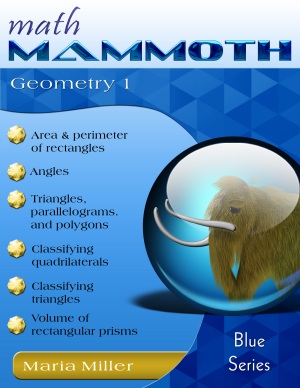Equilateral, Isosceles, and Scalene Triangles
This 5th grade geometry lesson defines equilateral, isosceles, and scalene triangles, and has a variety of exercises, including drawing exercises, about these topics for students.
|
If all three sides of a triangle are congruent (the same length), it is called an equilateral triangle. Equi- refers to things that are the “same” or “equal”, and lateral means “sided.” Think of it as a “same-sided” triangle.
|
If just two of a triangle’s sides are congruent, then it is called an isosceles triangle. Think of it as a “same-legged” triangle, the “legs” being the two sides that are the same length. Mark the two congruent sides of each isosceles triangle:
|
|
Lastly, if none of the sides of a triangle are congruent (all are different lengths), it is a scalene triangle.
|
|
1. Classify the triangles by You can mark each |
 |
2. Fill in the table by classifying the triangles labeled as (a), (d), (e), and
(g) above as “acute,” “right,”
or “obtuse” (by their angles), and also as
“equilateral,” “isosceles,” or “scalene” (by their sides).
| Triangle | Classification by the sides | Classification by the angles |
| a | ||
| d | ||
| e | ||
| g |
|
3. Plot the points, and connect them
with line Triangle 1: (0, 0), (4, 0), (0, 4) ___________________________ and ___________________________ Triangle 2: (5, 5), (1, 8), (9, 4) ___________________________ and ___________________________ |
 |
4. Plot in the coordinate grid an acute scalene triangle.
![]() 6. a. Draw a scalene obtuse triangle where one side is 3 cm and another is 7 cm.
6. a. Draw a scalene obtuse triangle where one side is 3 cm and another is 7 cm.
Hint:
Draw the 7-cm side first, then the 3-cm side forming any obtuse angle with the
first side.
b.
Measure the third side.
Compare your triangle to those of your classmates, or draw another
one yourself.
Can you draw several
different-looking triangles with this information,
or are they all identical
(congruent)?
![]() 7. a. Draw an isosceles right triangle whose two sides
measure 5 cm.
7. a. Draw an isosceles right triangle whose two sides
measure 5 cm.
Hint: Draw a right angle first. Then, measure off the 5-cm sides. Then draw in
the last side.
b. Measure the third side. It is ____________ cm.
Compare your triangle to
those of your classmates, or draw another
one yourself.
Can you draw several
different-looking triangles with this information,
or are they all identical
(congruent)?
![]() 8. a. Draw any isosceles triangle.
8. a. Draw any isosceles triangle.
Hint:
Draw any angle. Then, measure off the two congruent sides, making sure they have
the same length.
Then draw the last side.
b. Measure the angles of your triangle. They measure ________ °, ________ °, and ________ ° .
The angle sum is ________ ° .
9. Measure all the angles in the
isosceles triangles (a) and (b).
Continue their sides, if necessary.
a.
 |
b.
 |
|
_________ °, _________ °, and ________ ° . The angle sum is ________ ° . |
_________ °, _________ °, and ________ °. The angle sum is ________ ° . |
What do you notice?
__________________________________________________________________________________
__________________________________________________________________________________
|
There
are two angles in an isosceles triangle that have The remaining angle is called the top angle. |
Can you find the top angle and the |
10. The angle at A measures 40°.
Draw another angle of 40° at B, and then continue its side
so that you get an isosceles triangle with 40° base angles.

Measure the top angle. It is _______ ° . The three angle measures add up to _______ ° .
![]() 11.
a. Draw an isosceles triangle with 75° base angles. (The length of
the sides can be anything.)
11.
a. Draw an isosceles triangle with 75° base angles. (The length of
the sides can be anything.)
Hint: start by drawing
the base side (of any length). Then, draw the 75° angles.
b. Measure the top angle. It is _______ ° . The three angle measures add up to _______ ° .
c. Compare your triangle to
those of your classmates, or draw another
one yourself.
Can you draw several
different-looking triangles with this information, or are they all identical?
|
14. a. Could an equilateral triangle be a right triangle? If yes, sketch an example. If not, explain why not. |
b. Could a scalene triangle be obtuse?
If yes, sketch an example. If not, explain
why not.
c. Could an acute triangle be scalene?
If yes, sketch an example. If not, explain
why not.
d. Could a right triangle be scalene?
If yes, sketch an example. If not, explain
why not.
e. Could an obtuse triangle be equilateral?
If yes, sketch an example. If not, explain
why not.
This lesson is taken from Maria Miller's book Math Mammoth Geometry 1, and posted at www.HomeschoolMath.net with permission from the author. Copyright © Maria Miller.
Math Mammoth Geometry 1
A self-teaching worktext for 4th-5th grade that covers angles, triangles, quadrilaterals, cirlce, symmetry, perimeter, area, and volume. Lots of drawing exercises!
Download ($6.90). Also available as a printed copy.







